
Onewheels are not cheap. If you are considering buying one, you want to make sure it last. So how long can a Onewheel last for?
Onewheel lifespan is generally measured in miles. One has been recorded to last over 30,000 miles by Javier Starks (a.k.a. ‘OnewheelWing‘). While the Onewheel has lasted over 30,000 miles, several components require replacing. Most parts are replaceable however some repairs may void the warranty.
How Long Can You Expect Your Onewheel to Last?
Unfortunately, this answer is “it depends”. Most riders that have Onewheels that have died prematurely attribute the cause to be battery or water related. That being said, these two areas should be the focus for your Onewheel care so that you can achieve maximum mileage and many years from your Onewheel purchase. Terrain doesn’t play a heavy role in the longevity of the board. Salts (from beach riding or riding on an icy road that has been salted) do damage the bearings over time.
Regardless of model, the Pint, XR and GT all have similar components. The Pint and GT line do have a higher degree of water resistance however generally speaking, the components wear relatively similar across all boards. Below is a component list with an approximated lifespan for the part. The Onewheel as a whole isn’t going to just fail on you. It will be a component that needs replacing. Just as an electric skateboard, many parts are replaceable. Here is the breakdown.
Onewheel Component Part List
| Part | Lifespan | Replaceable | Cost |
| Tire | 800 – 1500 miles | YES | $80-$140 |
| Footpads | Lifetime | YES | $50-$250 |
| Griptape | 3000 – 5000 miles | YES | $10-$30 |
| Fender | Lifetime | YES | $0-$250 |
| Rails | Lifetime | YES** | $125-$750 |
| Bumpers | 3000 miles – Lifetime* | YES | $50-$100 |
| Battery | 1000 charges* | YES** | $200-$800 |
| Bearings | 2000-4000 miles | YES** | $50-$130 |
| Controller | Lifetime | YES** | $300-$650 |
| BMS | Lifetime | YES** | $125-$500 |
| Hub Assembly (motor/stator) | Lifetime | YES** | $400-$700 |
| Battery & Controller Box | Lifetime | Yes** | $125-$325 |
| Light bars | Lifetime | Yes** | $100-$200 |
**Voids Warranty.
Most Wearable Parts on a Onewheel
Whether we’re talking about the Onewheel Pint or GT line, the most wearable item on a Onewheel are rather inexpensive. The tire, bumpers, grip tape and battery are the likely the first items to show a Onewheel’s age. The good news is that these items can be purchased relatively easily and rather inexpensively too.
Key considerations are if you are ok with voiding the warranty as some elements of repair do void the warranty. Do not worry however if you are simply replacing bumpers, rail covers, footpads, grip tape or tires.
Tire Replacement and Lifetime
You can’t hit a top speed with a flat tire. This commuter vehicle is safely operable with a healthy tire. tire replacement can be easily replaced for about $120 (cost of the tire and tire sealant) and an hour of time. A tires lifespan will vary on how often you ride on hot surfaces and what tire pressure you tend to ride. Generally they tend to last 700-1100 miles. That’s about a years time if you ride a few miles each day.
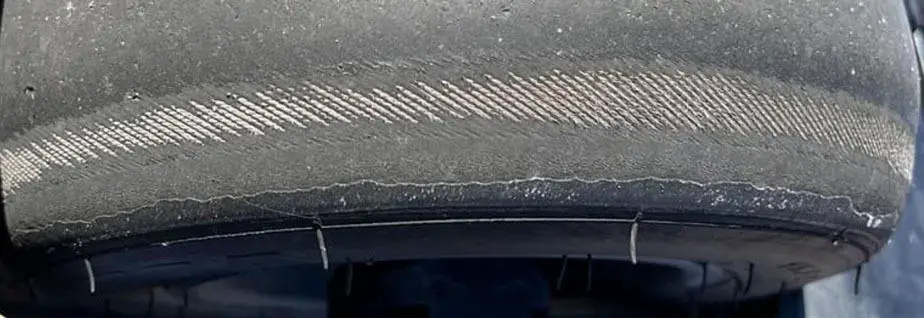
It is very feasible to go up to 1500 miles or so on a tire however with the option of sending the board into Future Motion for a tire replacement, it would be advisable to swap these every 1000 miles or so. Replacing the Onewheel tire yourself will save you money. Its also important to know that tires have the ability of being plugged. Plugging a tire leak is simple and it is a recommended tool for all Onewheel riders.
Onewheel Bumpers are Intended to be Replaced
Bumper can last a lifetime. They are intended to be wearable and that is what they are made for. Doing skid stops (quick stops) however will prematurely wear through the bumper exposing the battery box. The plastic of both the bumper and the battery box are relatively thin. You do not want to expose the inners of the battery box as this can severely damage the board.
Because bumpers are so thin and flimsy, many riders opt for B.A.N.G.S. which are thicker and smoother allowing for more protection and ability to tail or nose slide (grind) objects. Land Surf has released their version of bumpers called “Bash” that are similar to B.A.N.G.S. in that they are extremely thick and smooth.
An alternative to constant bumper replacements is to buy float plates. Float plates are an extra layer of thicker plastic that bolts to the underside of the footpads. Some riders suggest that these are redundant because the intent of the bumper is to be used for wear. If you are a cautious rider, float plates are a good option for maintaining a lifetime use out of your stock bumpers. They add little extra weight to the board (8 to 12 oz).
Grip tape and Footpad Lifetime
Stock grip tape can last thousands of miles (up to 5000 miles) however it will depend on the shoes you wear and the terrain ridden. Grip tape is very personal and customizable, this can be changed however it is important to keep in mind that peeling the grip tape off of the front sensor has potential in damaging the footpad sensor. It is imperative to use a heat gun and be careful. Instead of replacing the grip tape, some riders simply go over the footpads with newer ones which alleviates the issue of damaging the front sensor.
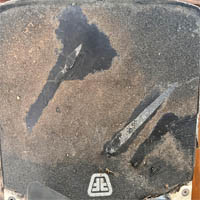
Foot pad options are vast and range in material. From foam concave pads to wooden or hard plastic, The material is going to determine how long they will last. I opted for a foam pad to alleviate some of the foot fatigue I was experiencing however that trade in comfort was in exchange for a footpad that didn’t last as long as it should have.
The pad lost some of its grit over the course of 500 miles or so of heavy trail riding. Personally however I am willing to make that trade and will do it again. Foam footpads simply add a little added shock absorption for the ride that I need.
Front Sensor Lifespan
The front footpad houses the motor engagement sensor. This sensor can wear over time however if the Onewheel hasn’t seen extreme weather, it does have potential to last the lifetime of the board.
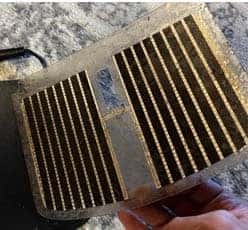
The sensor is wrapped in an “onion” which is essentially a plastic film protecting it. Water infiltration, blunt force and extreme weather conditions can wear this sensor prematurely. Future Motion does sell replacement sensors for $120-$150. There is also the option of replacing the sensor with a Posi sensor giving the rider options and customization.
Sensor modification or replacement does not void the warranty. The replacement labor is simple enough to complete within a half hour’s time. It is important to note however this is a modification that may cause malfunction and/or ghosting if done incorrectly. This is why you may commonly see modified rear footpads however on the front foot, the stock foot pad remains. The front foot sensor controls motor engagement. Some riders just do not want to mess with this.
Battery Replacements and Lifetime
Regardless of what model Onewheel you are riding, XR, Pint and GT Onewheel battery replacements will void the warranty. Generally, the stock battery should last you for several years and several thousands miles of usage however improper storage and charging technique can diminish its lifetime. Checkout our post on proper battery maintenance or ways to get more range. The main take away here is, climate storage, avoid storing with a full charge over long periods of time and try not to keep it at 100% for too long before riding.
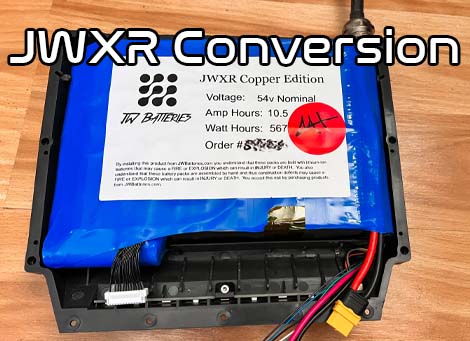
One of the most popular / warranty-voiding mod that is out there is upgrading your Onewheel battery. Several older Pints upgrade to a “Quart” and many older XR Onewheels complete a CBXR or JWXR conversion.
Especially if you have owned your Onewheel beyond the warranty coverage timeframe, replacing the battery is a great way to regain some lost mileage due to bad battery cells. Its more inexpensive to replace the battery than to buy a completely new Onewheel. You do need to research which model you have and what hardware the Onewheel has. Some require additional parts or do not allow you to disconnect the battery.
Replacing Onewheel Internal Components
To have to replace an internal component such as a motor, stator, bearings, BMS or controller. It is recommended to take the board to a Stoke Life Services shop where they can run diagnostics on the Onewheel. These repairs should not discourage newcomers. It is rare for casual riders to have issues with these components unless the board has been abused (frequent riding in extreme conditions [beach, snow, rain]).
A typical rider who wants to enjoy the casual riding of trails and streets can generally expect to see a year of maintenance free issues on their Onewheel. After that, a tire may need replacing however it wont be for many more years that any of the other issue would arise. Obviously this depends on how hard the board is used but Onewheels are rather resilient and can take a good beating for several years before they need internal component replacement.
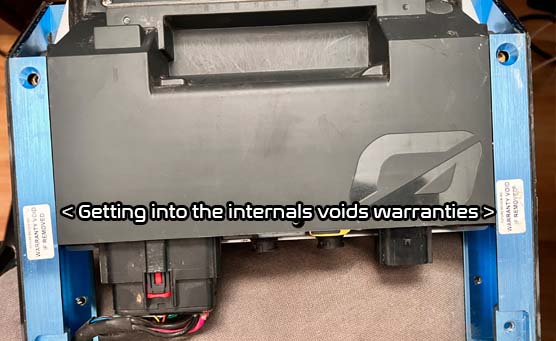
Riding Conditions
I essentially ride my Onewheel exclusively on trails, dirt, rocky roads, etc. It is important to consider that riding conditions do play into some of the lifespan of your onewheel components. Dirt is generally harmless. Get the board dirty. Snow, riding coastlines and rain however do and can cause parts to wear prematurely (primarily beach riding).
Salt and beach sand even is tough on the bearings. Over time, if you continually ride beaches you may notice a drop in range and performance. If you are doing proper board and battery maintenance then its reasonable to conclude that bearings need replacement. While bearings are not entirely expensive, this is the most difficult repair as it usually requires a hydraulic press to repair them properly.
If you want to protect your investment, I personally would keep your board off of the beach or buy a secondary board solely for enjoying the sand. This way your main board will perform as intended and will continue to deliver its potential performance output and maximum range.
Wear Safety Gear
While this is tangential to how long your Onewheel will last, I find that most boards will actually outlast their riders. What typically occurs is that the rider has sustained some injury and now they want to sell their Onewheel. This is the primary reason you can find so many used Onewheels in good condition. Wear at the very least a helmet and wrist guards and you will minimize the fall that will suck the fun out of riding. Its a simple and small learning curve to learning how to ride. Especially on your first ride, you need to make sure you are geared up and have watched a couple videos on the basic functions of the Onewheel. Check out our checklist for how to ride a Onewheel.
Be Safe on the Onewheel
This is an extension of the above, but it really needs to be added that the Onewheel is a ‘one wheel device’. For this reason its extremely agile but has device limitations that cannot be exceeded without resulting in a nosedive that could cause injury. Onewheels vary from traditional electric skateboards in that if you hit the performance limit of a skateboard, it essentially stops accelerating. The way a Onewheel is designed, if you continue to push on the accelerator (angling the board to accelerate), at some point you will over power the board and it will nosedive.
Its important to stay within its reported speed limits so that the Onewheel does not outlast you – the rider. There have been a few deaths from riding and this is while the Onewheel community stresses safety gear.
Top Rider’s Chart on Onewheel App

These are currently the top 5 riders (daily streak) for each model. As you can see from their mileage, whether they are riding a Pint or a GT, thousands of miles is not an uncommon occurrence.
Like many that join the sport, you may find yourself proactively replacing components for a more custom feel or to better the board for trick or trail riding. Rails, Flight fins, custom batteries are generally the gateway to the custom Onewheel world. Once you start that, you likely wont care if the warranty has been voided.
My Quick Tips For Maximizing The Onewheel’s Lifespan
- Never keep your Onewheel stowed in your car. The extreme heat or cold is taxing on the battery. GTs are known for being out of temp range and may not even turn on when you want it to. You end up having to wait until its within the temperature range to ride it.
- Avoid using hyper-chargers. The fast charging wears out the battery prematurely. If you own a hyper-charger, use it on a group ride or very sparingly. Never use it daily.
- Avoid keeping the battery at 100%. Do this only if you intend to ride it within 24 hours.
- Buy a basic brush and clean the dirt and debris off the Onewheel off after every trail ride. Do not spray off the board ever (even if its waterproofed).
Summary
If your Onewheel or potential Onewheel purchase is for the intent of commuting with limited trick riding, expect to get maximum life out of the wearable components. Do the regular maintenance on the Onewheel (battery balancing), use power plug covers and avoid the rain or wet conditions. Yes, the Onewheel is relatively water resistant however water still wears the bearings. I cannot emphasize enough that proper battery maintenance will ensure maximum battery life.
Some other things to consider is to store the Onewheel in a climate controlled area, ride the board within its limits, always wear safety gear and you’ll likely never want to part with the Onewheel.
F.A.Q.’s
Onewheels can last over 5 years however Its better to represent the time as miles ridden. If you maintain the battery and properly store the Onewheel, standard components can last up to 2,000 miles. You may need to replace the tire within that timeframe depending on the terrain you commonly ride. Batteries can typically last this time if properly stowed and charged within this time. Decide which onewheel is best for you and ride.
Javier Starks (a.k.a. ‘OnewheelWing‘ currently testing the capabilities of his Onewheel XR. Currently he is exceeding 35,000 miles on his Onewheel.
It’s not recommended to ride the Onewheel on the beach. While Future Motion does advertise the Onewheel on beaches, the salt can wear the board out prematurely (notably the bearings). In short, you can ride on the beach however more frequent maintenance may be needed.
Only leave your onewheel fully charged if you anticipate riding within a days time. Otherwise, leave it at around 50%. A fully depleted or fully charged battery can sen dyour battery into premature death.

3 thoughts on “How Long Can a Onewheel Last?”